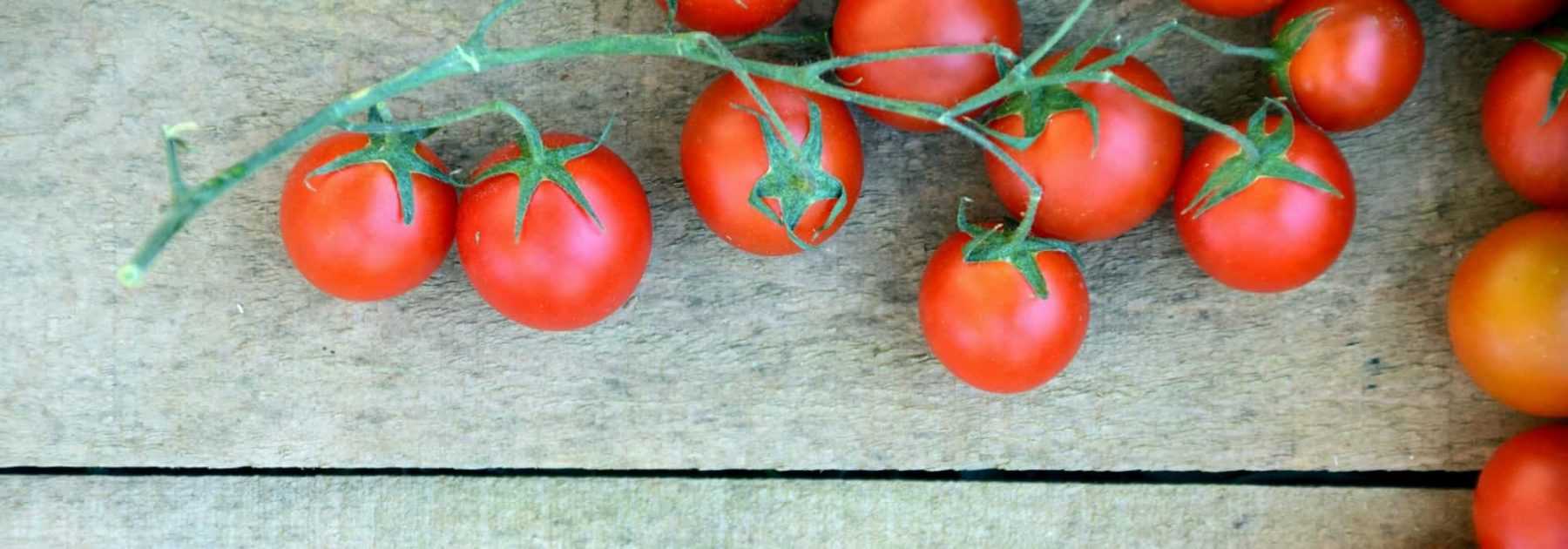
Tomato: Blight, Other Diseases and Pests
Identify, prevent and treat
Contents
The tomato is one of the most widely grown vegetable fruits in kitchen gardens. Relatively easy to sow and plant, its cultivation can sometimes prove a bit tricky, as it is prone to blight (Phytophtora infestans), as well as other diseases and pests that jeopardise the eagerly awaited harvest.
What are the main tomato diseases, and how can you recognise them? How to prevent and treat them? How to keep parasites and pests away from your tomatoes?
Discover all our tips and solutions to keep your tomato plants healthy and enjoy abundant harvests!
→ To learn more about blight, you can also listen to our podcast:
https://open.spotify.com/episode/2Vf71N7F0bpJPqPSFwqlff?si=G128mNRORXO0Br31b7waaw
Tomato blight: the main disease
Blight is the most common tomato disease. It mainly appears during wet and rainy summers and spreads quickly, usually causing the rotting of already formed fruits and then the death of the young plants.
Symptoms
The first signs of tomato plants being infected by blight can initially be observed on the foliage: small brown spots, with a slightly oily appearance, appear. They enlarge and quickly turn blackish. Very quickly, these spots spread to the tomato stems, then to the clusters of flowers and fruits, which eventually rot on the plant. Without intervention, the tomato young plant dies quickly, destroying any hope of harvest.
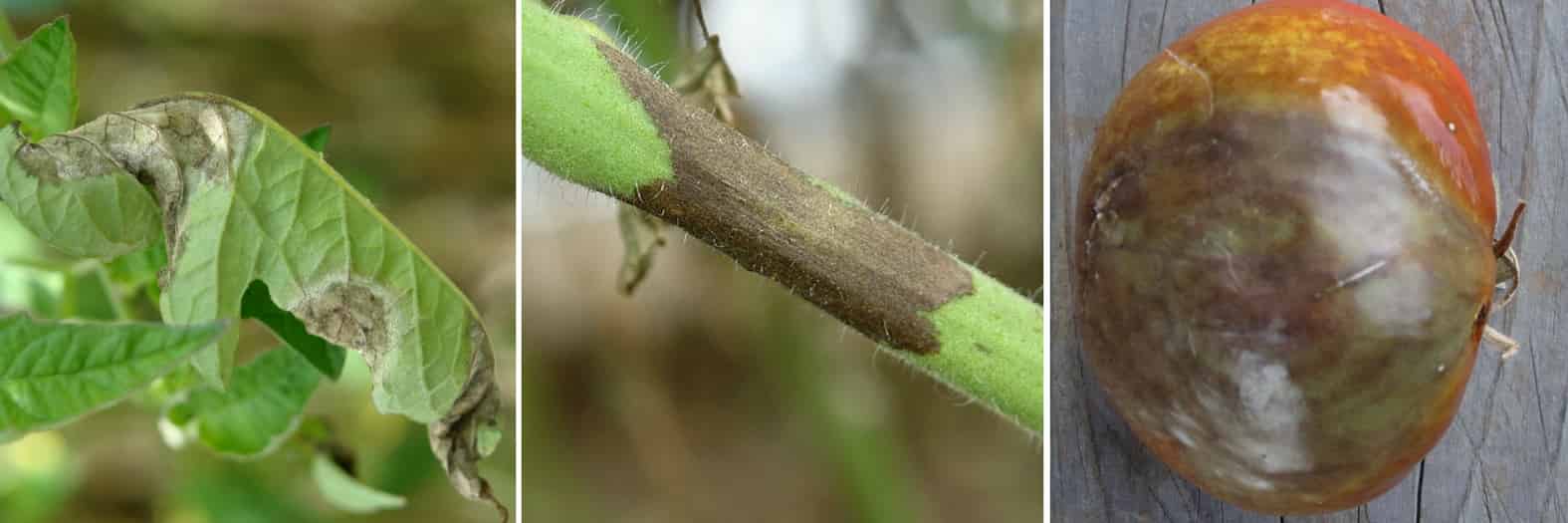
Blight – Phytophthora infestans – damage on leaf, stem and fruits
Causes
Blight is a fungal disease, caused by a fungus: Phytophthora infestans. This is a fungus that spreads by wind and affects the aerial parts of the plant. It is particularly prevalent during periods of high humidity (rain, dew, but also high atmospheric humidity) and when the temperature is between 16 and 22°C.
Read also
Sowing tomatoes and transplanting themPreventing tomato blight and limiting its spread
In the vegetable garden as elsewhere, prevention is better than cure! The key preventive measure is to create conditions unfavourable for this fungus to establish itself on tomato plants. This mainly involves combating moisture.
Here are 6 preventive measures to avoid blight:
1. Shelter your tomatoes
Where possible, grow your tomatoes under cover. This could be a greenhouse, a tunnel or a temporary, more affordable structure like this tomato shelter (which also has the advantage of being movable, making crop rotation easier).
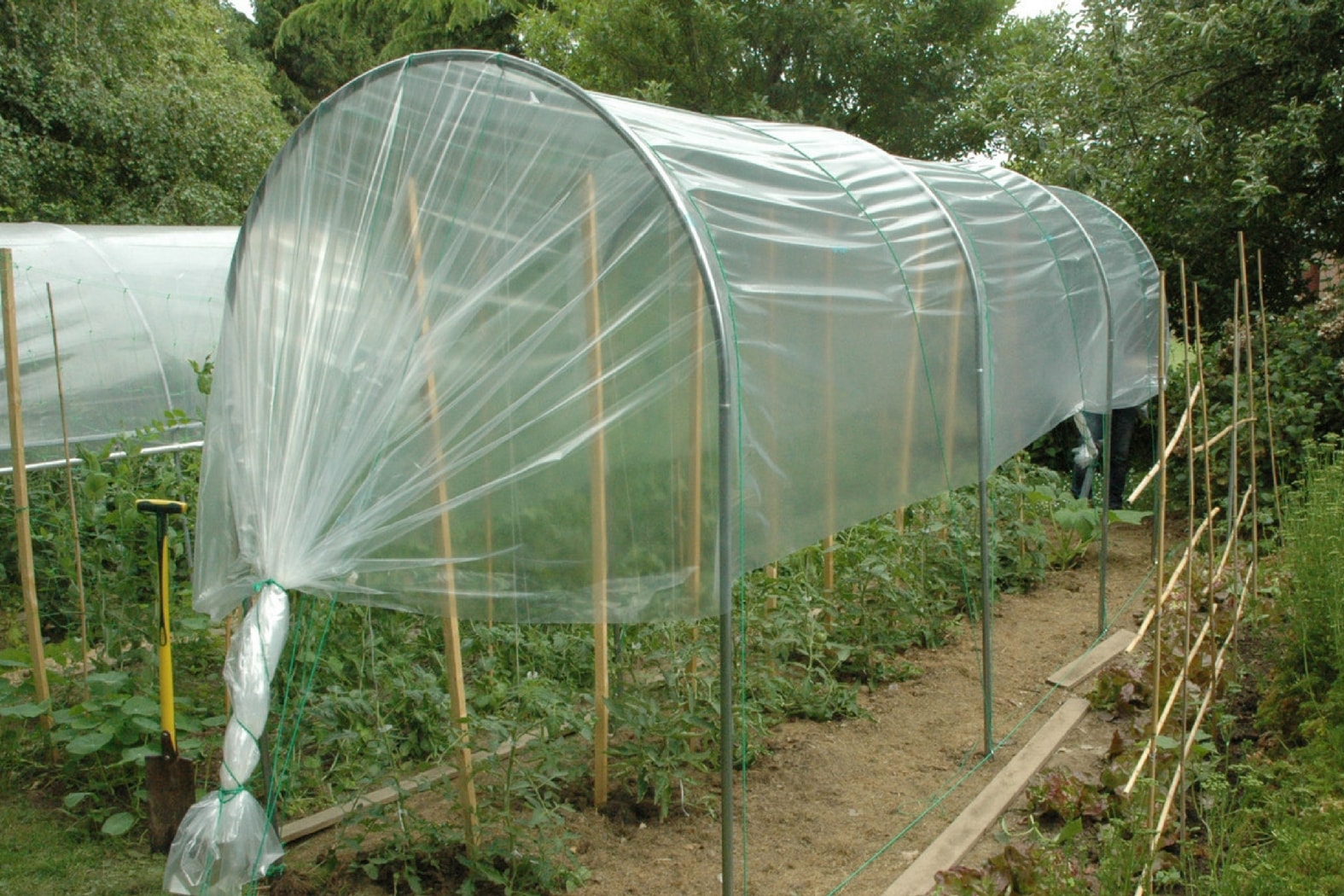
Temporary tomato shelter – Serres Natural: an effective and practical way to protect your crops
DIY enthusiasts can also build their own shelter – often just a simple roof over the tomato plants is enough to limit damage.
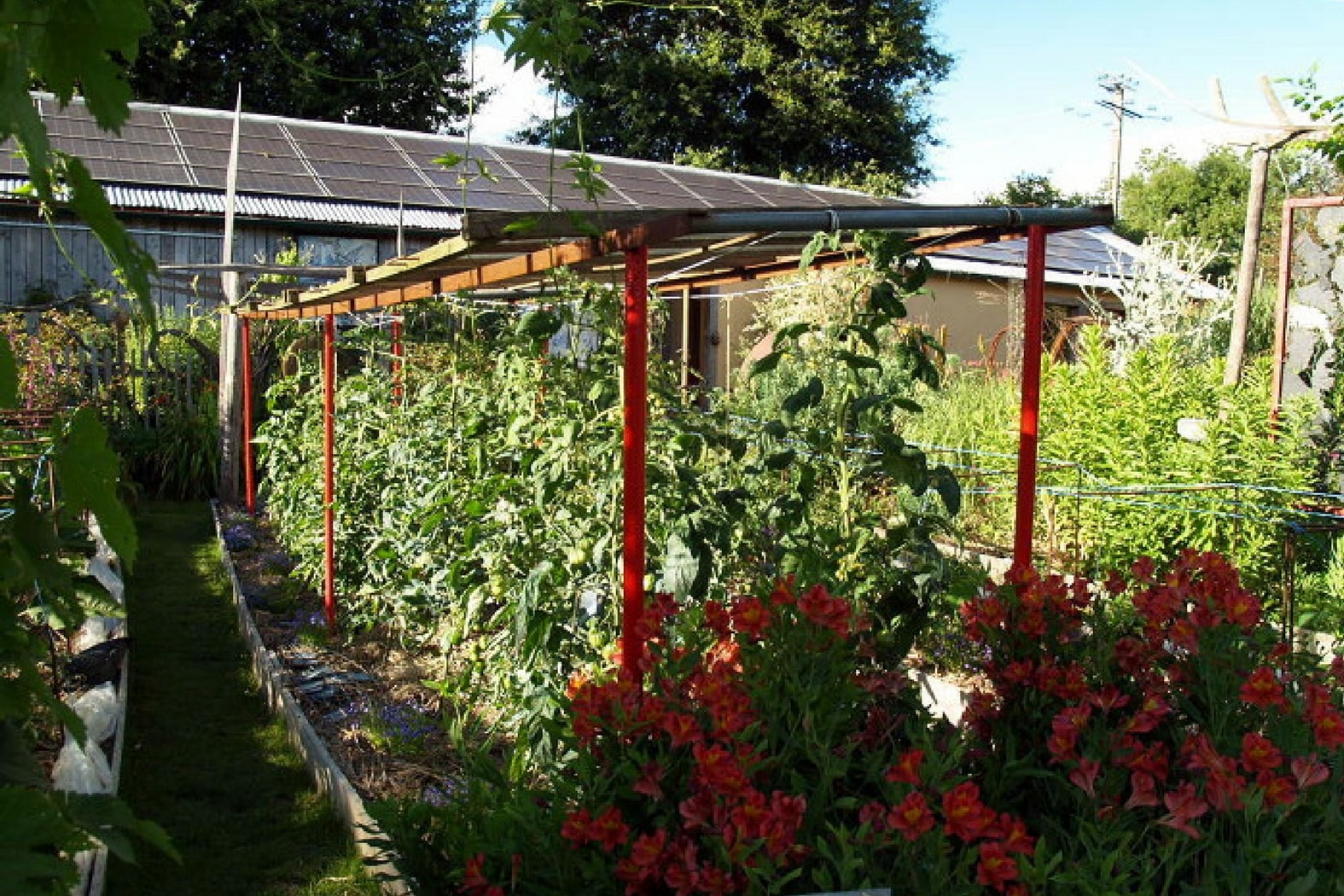
a shelter to protect tomato plants at Les Jardins de Rocambole
2. Space your plants sufficiently
Since moisture is the main factor encouraging blight, your outdoor tomato plants must be able to dry quickly. For this, air circulation is essential. That’s why we recommend maintaining good spacing between plants: at least 50-60 cm, or more if you have extra space in your vegetable garden.
Note that blight can occasionally occur under cover, especially when shelters aren’t properly ventilated. If growing tomatoes in a greenhouse or tunnel, always open doors and vents to create air currents.
3. Prune your tomatoes… or not!
Among the reasons for pruning tomatoes is to limit vegetation and improve air circulation. Similarly, it’s recommended to remove leaves at the base of the plant so they don’t get wet during watering.
However, when pruning tomatoes, removing side shoots creates wounds that provide entry points for disease.
Therefore, if you do prune your tomatoes, we recommend being attentive and removing shoots in the axils while they’re still small, to limit wound size.
4. Water carefully
Tomatoes should never be watered by sprinkling. On hot summer days, it might be tempting to shower the entire plant to cool it down. This is a very bad idea. Tomatoes should always be watered carefully, at the base, ensuring leaves don’t get wet.
To learn all about watering tomatoes, see our advice sheet: “Watering tomatoes – how to do it?”
To make these practices perfectly effective:
5. Practice crop rotation
Blight spores can survive in soil for several years. To prevent the problem recurring systematically, don’t plant tomatoes (or potatoes, which belong to the same botanical family, Solanaceae) in the same plot for 5 years.
6. Grow blight-resistant tomato varieties
Few varieties, apart from Honey Moon F1 tomato, are truly blight-resistant. However, some show notable tolerance worth mentioning. These are often modern F1 hybrid varieties bred for this quality, but also heritage varieties renowned for better flavour.
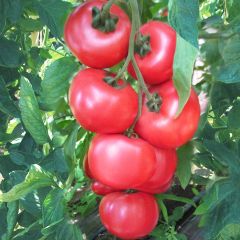
Tomato Honey Moon F1 Plants
- Flowering time July to October
- Height at maturity 1,50 m
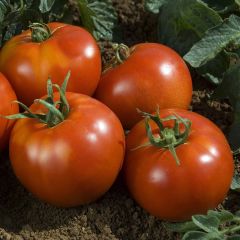
Fandango F1 Tomato
- Height at maturity 1,50 m
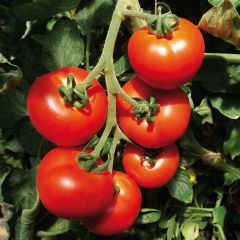
Tomato Previa F1
- Height at maturity 2 m

Maestria F1 Organic Tomato - La Sélection du Chef
- Height at maturity 1,80 m
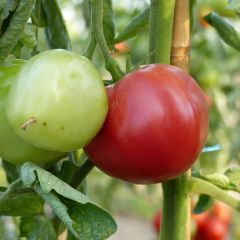
Tomato Rose de Berne
- Height at maturity 2 m
Preventive treatments for blight
1) Bordeaux mixture
The best-known preventive treatment is spraying with Bordeaux mixture. Made from copper sulphate and lime, Bordeaux mixture is an effective fungicide approved for organic farming. Against blight, it works best as a preventive.

Bordeaux mixture
When conditions favour blight:
- mix the Bordeaux powder with water at 2 grams per litre in a sprayer
- spray weekly, including the undersides of leaves
- repeat after heavy rain that might wash off previous applications.
Note that we suggest using Bordeaux mixture at reduced strength (often 10-20g per litre is recommended) because, although widely used and approved for organic gardening, it’s not without impact. Overuse leads to copper accumulation in soil which can become toxic, harming earthworms and soil fungi that contribute to soil life and humus formation.
→ To learn all about Bordeaux mixture, see our sheet: “Bordeaux mixture and other copper-based garden treatments”
2) Plant extracts
Natural solutions exist as many plants have fungicidal properties without environmental impact. To prevent blight damage, you can also use:
- horsetail decoction:
Dilute your decoction with water at 20% (250ml per litre) and spray on soil and plants every fortnight from planting until July, in the evening.
→ Find our ready-to-use horsetail manure or our guide to making your own.
- Bicarbonate of soda
Bicarbonate works by raising pH. Sprayed on foliage (3-10g per litre of water), it increases pH, slowing Phytophthora infestans development.
- Nettle manure against blight?
Nettle manure isn’t effective against blight. Its action is not antifungal but growth-stimulating. For tomatoes, it can be used at planting as a liquid fertiliser. Some gardeners spray it to stimulate leaf defences, but we don’t recommend this as wetting foliage could have the opposite effect.
→ To learn all about nettle manure, see our sheets: “How to make nettle manure – tutorial” and “nettle – a plant with many benefits”
Curative treatments: at the first signs!
There is no effective natural treatment for established blight. However, you can slow the disease by monitoring plants closely and removing infected leaves at the first symptoms.
Unless you have a compost bin that heats up properly (which is rare), we recommend burning infected material rather than leaving it on the ground.
Quick removal of affected parts, combined with spraying Bordeaux mixture or bicarbonate, can significantly slow attacks until fruit ripens, but rarely stops them completely.
Discover other Tomatoes
View all →Available in 1 sizes
Available in 1 sizes
Available in 1 sizes
Available in 2 sizes
Available in 2 sizes
Available in 1 sizes
Available in 1 sizes
Available in 1 sizes
Available in 1 sizes
Available in 1 sizes
Other diseases
As if blight wasn’t enough, tomatoes can be affected by other diseases, the most common of which are:
Alternaria blight or black rot
- Symptoms and causes:
Black, circular spots appear on the leaf and grow in a concentric pattern. The stems are also affected, displaying grey or brown spots, round or elliptical in shape. The young plant loses its leaves, the petioles are gradually affected, and the fruits also begin to rot.
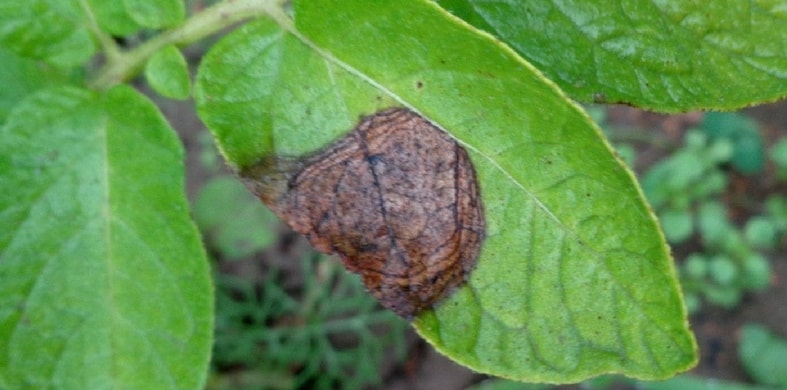
Alternaria blight
The culprit is once again a fungus: Alternaria tomatophila, which overwinters in the soil and also on seeds. It thrives when mild temperatures are combined with high atmospheric humidity.
- Preventive and curative treatments:
Preventive measures are the same as those recommended to avoid blight. As a curative treatment, spraying with a bicarbonate of soda or horsetail decoction solution yields satisfactory results.
Note that since this fungus can survive on seeds, it is prudent not to collect them from infected plants for seed-saving purposes.
Fusarium wilt
- Symptoms and causes:
Fusarium wilt is a disease that affects the roots of tomato plants at all stages of development. This disease leads to the complete decline of the plant. Brown-red lesions are observed on the collar of the plants, quickly developing into rot. The culprit: Fusarium oxysporum, a fungus that thrives in warm weather (around 28°C) and attacks the sap-conducting vessels.
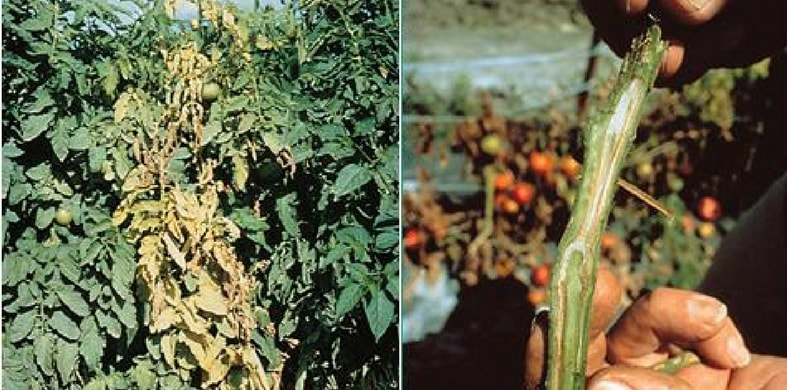
Fusarium wilt – Photo: The American Phytopathological Society
- Preventive and curative treatments:
There is no curative treatment. This fungus can survive in the soil for a very long time and can affect many botanical families. We therefore recommend removing and burning infected plants.
In subsequent years, grow your tomatoes from grafted plants, which are resistant to diseases, including fusarium wilt.
Verticillium wilt
- Symptoms and causes:
Although less severe than fusarium wilt, verticillium wilt is another disease that affects tomato plants in their entirety. Even if the plants do not necessarily die, fruit production is significantly slowed. Heirloom varieties are the most susceptible to this disease, while many modern varieties are resistant.
As always, it is a fungal disease that causes blockage of the sap-conducting vessels. It appears more often in mild weather, when temperatures range between 16 and 25°C. The pathogenic fungus responsible, Verticillium dahliae, capable of surviving in the soil, infiltrates the plant, causing wilting that begins with softening of the leaf. Yellow then brown V-shaped spots (like Verticillium… almost a signature!) appear, followed by total leaf necrosis. Sometimes, the plant appears affected on only one side. Cut a stem crosswise and observe: the presence of brown areas at the core is a telltale sign.
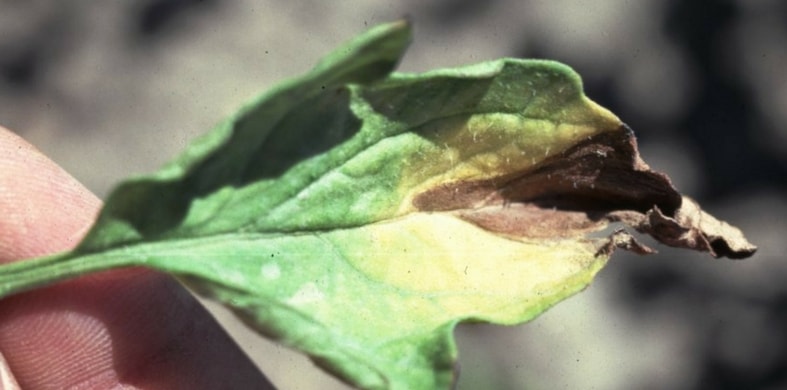
Verticillium wilt – Photo: Ministry of Agriculture, Food and Rural Affairs – Ontario
- Preventive and curative treatments:
Verticillium wilt is more common in rich soils: to avoid it, do not over-fertilise!
There is no curative treatment. Growers with affected crops are forced to disinfect their soil. However, to limit damage, we advise acting at the first signs of symptoms by removing affected parts. Some gardeners have reported good results by spraying their plants and watering the soil with plant extracts (horsetail, comfrey).
Be careful, as this disease spreads easily: clean your tools thoroughly with alcohol between each plant and maintain this habit during future pruning.
→ Read our detailed guide on verticillium wilt as well as our article on ToBRFV, a brand-new virus threatening tomato, pepper, and chilli crops
Read also
Growing Tomatoes SuccessfullyBlack bottom, curled leaves...: physiological disorders
In addition to diseases, it often happens that tomato young plants are affected by disorders that might suggest they are diseased. These are actually minor issues unrelated to any bacterium or fungus, but rather linked to growing conditions.
- Blossom end rot or apical necrosis
Blossom end rot is relatively common, especially in long-fruited varieties like Andine Cornue. This phenomenon, called apical necrosis, manifests as a large brown or black spot at the lower end of the fruit.
It is a symptomatic disorder of a calcium deficiency that occurs when the soil lacks it, but not always. Most often, the cause is irregular watering (alternating dry periods followed by heavy watering) which makes this calcium unavailable to the plant.
The solution lies in the problem: water moderately but more frequently and mulch around the base of your tomatoes to retain moisture!
In naturally acidic soil, if the problem persists despite regular watering, consider making a measured annual calcium supplement (the pH of soil should never be abruptly altered) in the form of dolomite, for example.
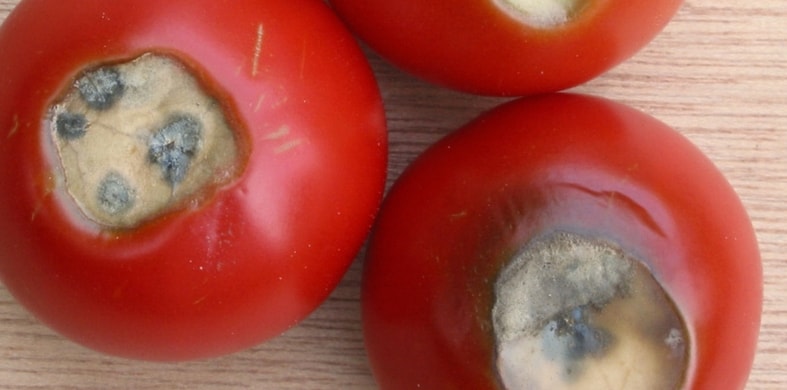
“Blossom end rot” or apical necrosis
- Fruit cracking
Tomatoes, ready for harvest, that crack and split, making even short-term storage impossible, is another common issue in the vegetable garden. This disorder is also caused by irregular or excessive watering.
If this occurs late in the season when thunderstorms are more frequent and your tomatoes are grown outdoors, unfortunately, there’s nothing to do but pick the fruits a bit early to let them ripen at home.
- Curled leaves
Sometimes, tomato leaves curl up, showing their undersides. Relatively common, this phenomenon isn’t very serious but indicates stress in the tomato plant. This can be caused by many factors: often a harmless virus, excessive nitrogen fertilisation, high temperatures (temperatures rise quickly under cover), overly irregular watering, or overly compacted, suffocating soil.
To avoid this issue, loosen your soil well before planting, use nettle manure sparingly, ventilate your shelters and water regularly but moderately.
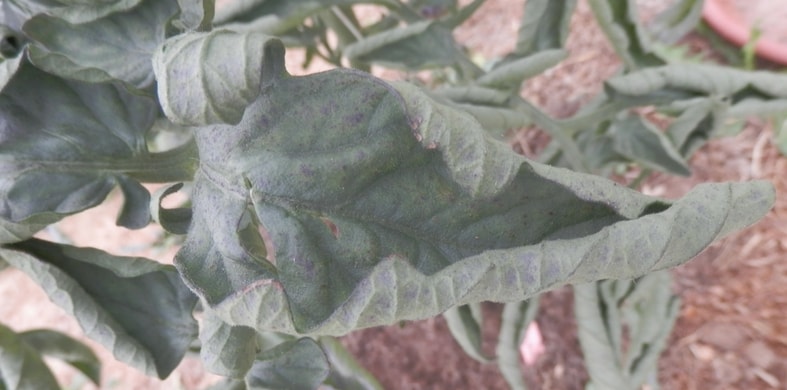
Curling of tomato leaves
Tomato Pests and Parasitic Organisms
Good news! In amateur gardeners’ vegetable plots, tomato pests are far fewer than diseases. Among them are:
- Root-knot nematodes (Meloidogyne):
These are microscopic worms that live in the soil. They attack the roots of tomato plants, forming galls that hinder proper plant development. Although greatly feared, these nematodes don’t seem particularly prevalent in private gardens.
To deter nematodes, it’s recommended to companion plant tomatoes with marigolds (tagetes), which are nematocidal, and to practice good crop rotation.
- Tomato fruitworm
The tomato fruitworm (Helicoverpa armigera) is a nocturnal moth. Of tropical origin, it’s typically found in warm climates, such as southern France. The damage is obvious and serious as this caterpillar, after attacking young leaves, turns to the fruits which it devours from the inside.
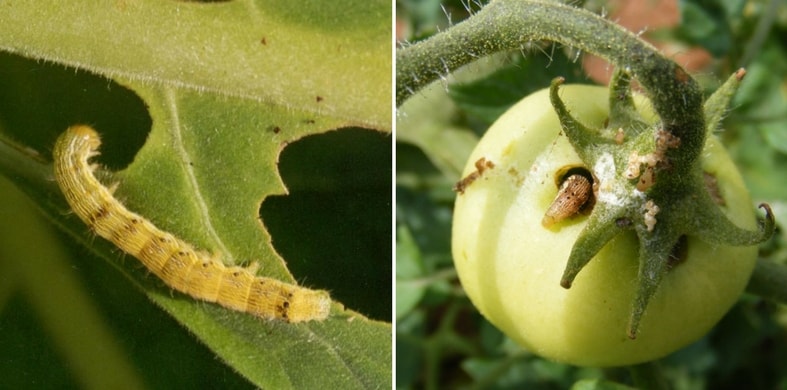
Damage caused by the tomato fruitworm – Helicoverpa armigera
Treatment:
The first measure is to handpick the caterpillars to destroy them (using pickle tongs makes the operation easier for those with insect phobias!). Supplement this collection with a spray of Bacillus thuringiensis (Bt), to be repeated every 10 days. Note that this product, approved for organic gardening, is only effective against very young larvae.
There is no prevention against this pest other than encouraging its natural predators such as bats and insectivorous birds.
- Mites: Two-spotted spider mite and Aculops lycopersici
The two-spotted spider mite (Tetranichus urticae), often called “red spider mite“, is actually a mite so tiny it’s only noticeable during severe infestations, when present in large numbers, or by the webbing it spins on plants. Varying in colour (yellow or red), it settles on leaves and stems, sucking their sap, as well as on fruits.
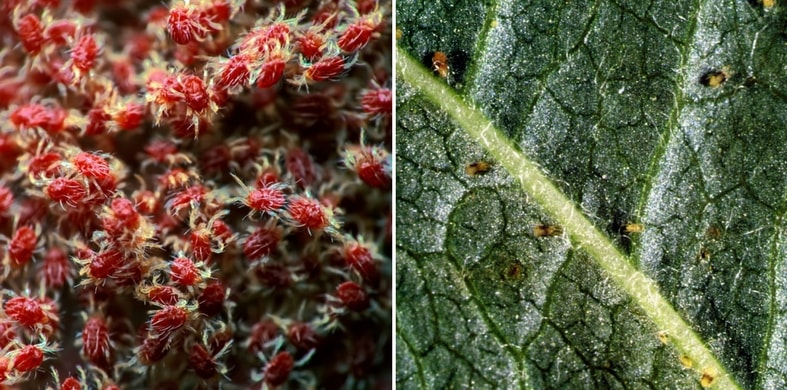
Two-spotted spider mite (Tetranichus urticae), often called “red spider mite”
Aculops lycopersici is another mite responsible for tomato russet mite or “tomato bronzing disease”, which causes shiny, bronze-green patches on leaves and stems. Fruits are also affected and develop cracks.
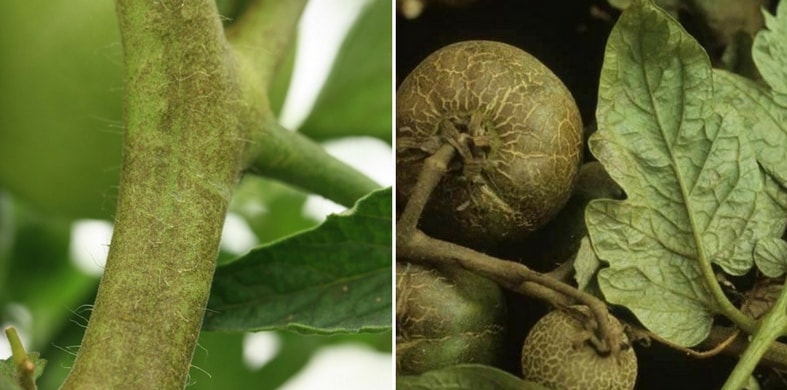
Tomato bronzing caused by Aculops lycopersici
Treatment:
For other plants, treatment involves spraying the foliage with water or a decoction of garlic, horsetail or tansy. This treatment isn’t advisable for tomatoes as it could encourage blight.
The best prevention: quality young plants!
The list of diseases and pests is long but, rest assured, apart from Blight, they are not so common and rather easy to avoid by following our advice, but also by choosing your young plants carefully.
The best way to have healthy tomato plants is to grow them from strong young plants. To do this, avoid buying them when they are too tall, sometimes leggy from a long stay in garden centres.
Whenever possible, sow your seeds or buy your small young plants as plug plants, and grow them at home, taking them out regularly to harden them off.
Finally, plant them in healthy soil, enriched with well-rotted compost and avoid over-fertilising, especially with nitrogen fertilisers: a fast-growing young plant may look visually satisfying but its softer tissues also make it more susceptible to diseases!
- Subscribe!
- Contents


































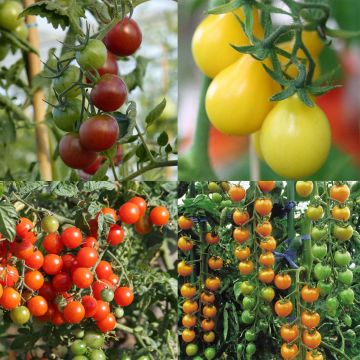

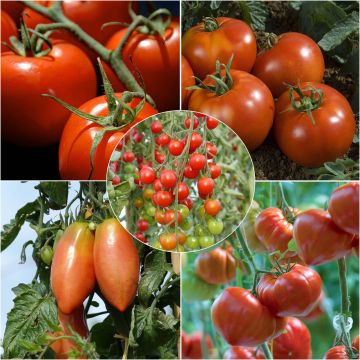

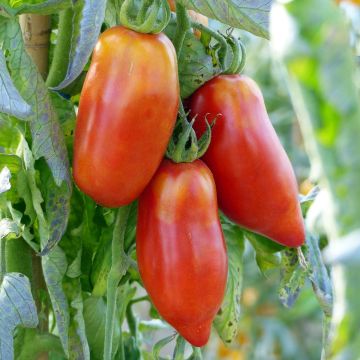
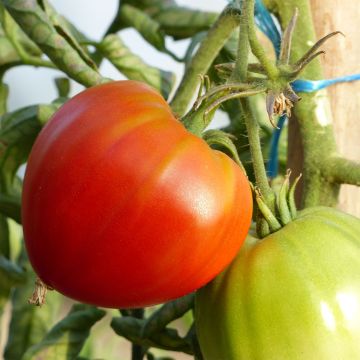
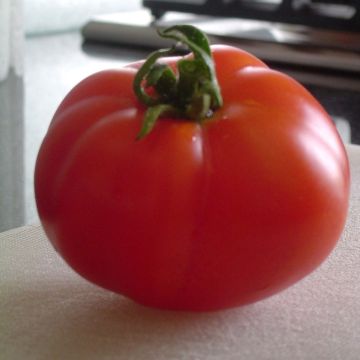
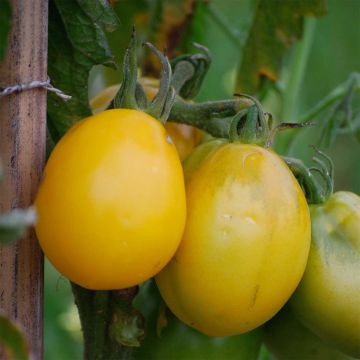
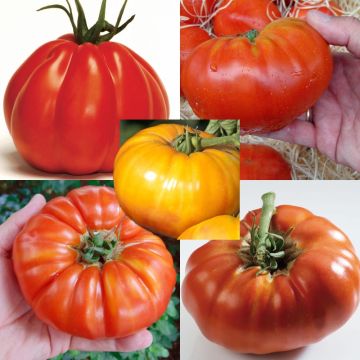
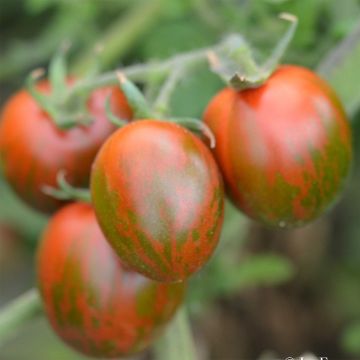
Comments